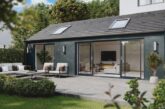
Becci Goldsmith, Product Manager, MEDITE SMARTPLY explains how you can achieve effortless airtightness and vapour control.
In the UK and Ireland, the quest for energy-efficient buildings is challenged by an ageing housing stock. According to the English Housing Survey (2021 to 2022), 62% of dwellings in England were constructed before 1968, and only 47.5% have an Energy Performance Certificate rating of C or above, which is considered efficient. The Department for Business, Energy & Industrial Strategy highlights that the residential sector accounted for 19% of the UK’s total final energy consumption in 2021. Similarly, in Ireland, data from the Sustainable Energy Authority of Ireland shows that about 50% of homes were built before 1990, with only 38% achieving a Building Energy Rating of B3 or above in 2021.
At the same time, over half (58%) of privately rented households in England are dealing with damp, mould and/or excessive cold in their homes, affecting approximately 2.7 million households. These conditions degrade living quality and highlight the inefficiencies in building envelopes that fail to control moisture and retain heat.
These statistics underscore the critical need for modern construction practices that prioritise airtightness to minimise energy loss while ensuring proper vapour control and ventilation to combat moisture-related issues. The balance between airtight construction and adequate moisture management is essential, not only for energy conservation but also to maintain healthy living conditions within these structures.

Moreover, the rising popularity of the Passivhaus concept, which does not require traditional heating or cooling systems, further emphasises the importance of robust air barrier properties in building materials.
The balancing act: airtightness, ventilation and vapour control
Airtightness refers to the building shell’s ability to prevent uncontrolled air leakage, a vital factor for thermal comfort and significant energy savings by reducing a building’s heating and cooling demands. Vapour control, on the other hand, manages the diffusion of moisture vapour within the building envelope, preventing the accumulation of interstitial condensation and mould. This is imperative for protecting the structural integrity of the building.
The push towards tighter building envelopes has led to a better understanding: while airtightness is essential for energy efficiency, it must be balanced with ventilation to prevent surface damp and mould issues, which are prevalent in poorly ventilated spaces, and lead to poor indoor air conditions.
This balance is critical in avoiding the pitfalls of condensation, which can lead to structural and health issues.
Innovations and applications
Innovative building solutions such as wood panels with integrated vapour control and air barrier properties are addressing these needs effectively. These products simplify the construction process while contributing to more energy-efficient buildings. For instance, the use of Oriented Strand Board (OSB) panels, such as SMARTPLY AIRTIGHT, that has airtightness engineered into the panel substrate and provides an integrated vapour barrier with consistently high vapour resistance over the entire surface. Used as structural sheathing in timber frame structures, such panels also enhance the buildings’ environmental credentials by reducing the buildings’ overall carbon footprint.

The integrated vapour control layer and air barrier properties eliminate the need for additional Air and Vapour Control Layout (AVCL) membranes. The coating also provides a smooth, durable surface for superior bonding of airtight tape at panel joints, simplifying both new build and renovation projects and shortening the installation time. It is easy to handle and can be readily cut and fixed using standard timber frame fixings. Being robust, there is minimal risk of damage during assembly, transport or erection, which means the airtightness is not compromised.
What does the future hold?
The trajectory for future building practices is clear: energy-efficient buildings that provide healthy spaces for occupants. This involves a deeper focus on the materials and technologies used in construction, particularly those that offer comprehensive solutions to the challenges of airtightness and vapour control.
As we look towards a future of buildings that are sustainable in the truest sense—economically, environmentally and socially—the principles of airtightness and vapour control become critical. Ensuring these standards will not only mitigate the sector’s extensive energy use but also elevate the living and working environments of millions, ultimately contributing to the broader goals of energy efficiency and sustainability.
Max Fordham House: a paradigm of energy efficiency using SMARTPLY AIRTIGHT

The Max Fordham House in the vibrant London borough of Camden is a prime example of energy-efficient construction utilising SMARTPLY AIRTIGHT wood panels. This contemporary three-bedroom Passivhaus, designed by bere:architects, features a thermal envelope that significantly reduces heat loss, enhancing the building’s environmental efficiency.
SMARTPLY AIRTIGHT has been crucial in achieving the airtightness required to minimise energy use significantly compared to standard building requirements. Selected by Bow Tie Construction, this product ensures durability, a high-quality vapour barrier, and consistently high vapour resistance over the entire surface. It also supports sustainability through its use of guaranteed sustainably manufactured and sourced timber products.
Max Fordham House has successfully achieved an Energy Performance Certificate rating of B 83. Unlike traditional membrane-based systems that are prone to damage, SMARTPLY AIRTIGHT provides a robust, reliable and efficient solution that excels in maintaining airtightness, even under rigorous testing. It’s an innovative approach that has positioned this solution as a preferred material for Passivhaus projects across the UK, contributing to the structure’s stylish, light-filled design and minimal environmental impact.
You can find out more about SMARTPLY AIRTIGHT at https://mdfosb.com/en/products/smartply-airtigh







